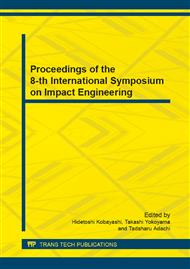p.379
p.385
p.391
p.397
p.403
p.409
p.415
p.420
p.426
Propagation of Underwater Shock Wave and Gas Bubble Behavior Induced by Electrical Discharge in Water
Abstract:
The basic behavior during underwater electrical discharge up to 10 kJ stored energy is investigated through both numerical analysis and optical-observation experiments. Since the authors have been investigating the use of underwater exploding phenomena for food processing and other applications, it is necessary to know the whole process which may affect the quality of the samples recovered. In the present investigation, the propagation of underwater shock wave was measured using a high-speed camera and compared with the numerically simulated results using LS-DYNA. Also, the motion of gas bubble, which is induced quite after the propagation of the shock wave, was measured and compared with the numerical simulation using the same code. The pressure of the bubble is not such high as the shock wave, but it is known that the impulse is not possible to be ignored due to its relatively long duration of the pressurization. Through a series of optical-observation experiments, it is confirmed that the numerical simulation is potentially possible to predict the whole phenomena for processing foods and other materials.
Info:
Periodical:
Pages:
403-408
Citation:
Online since:
June 2014
Keywords:
Price:
Сopyright:
© 2014 Trans Tech Publications Ltd. All Rights Reserved
Share:
Citation:


